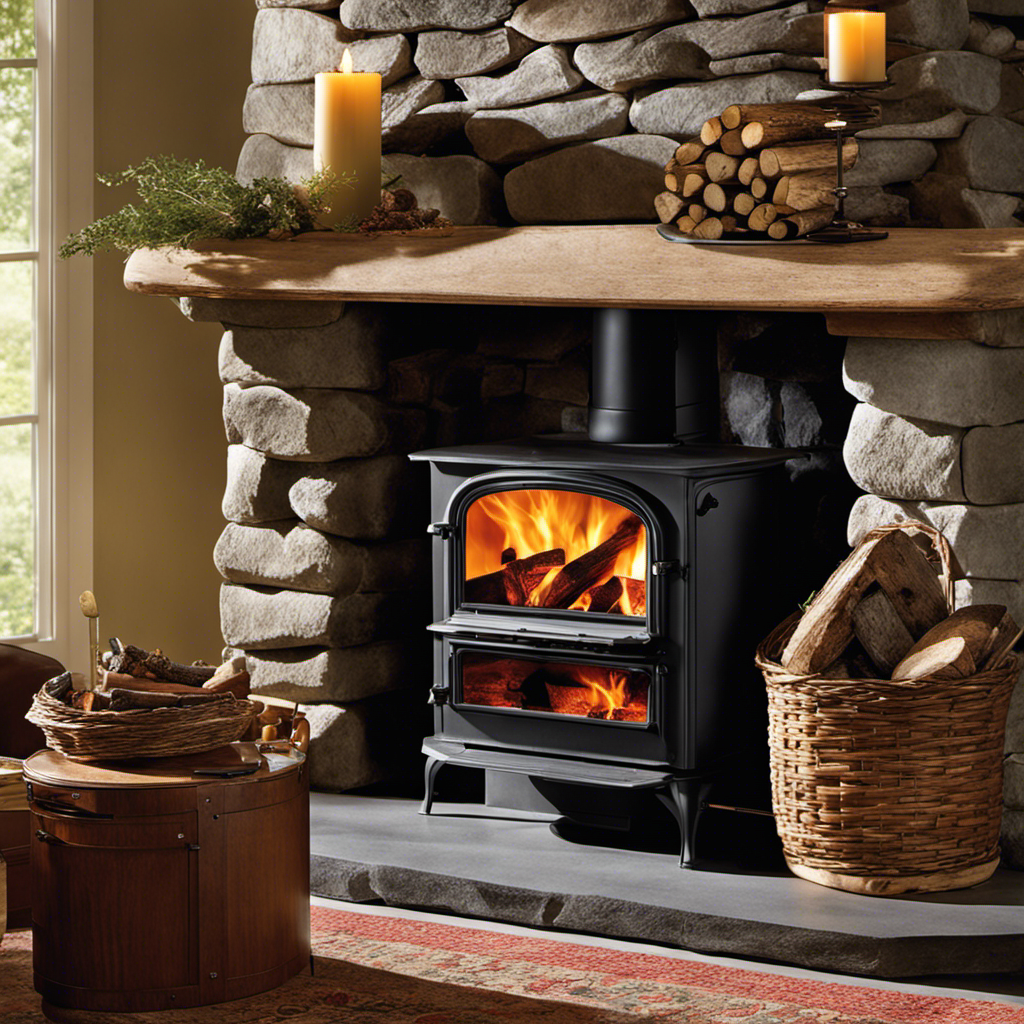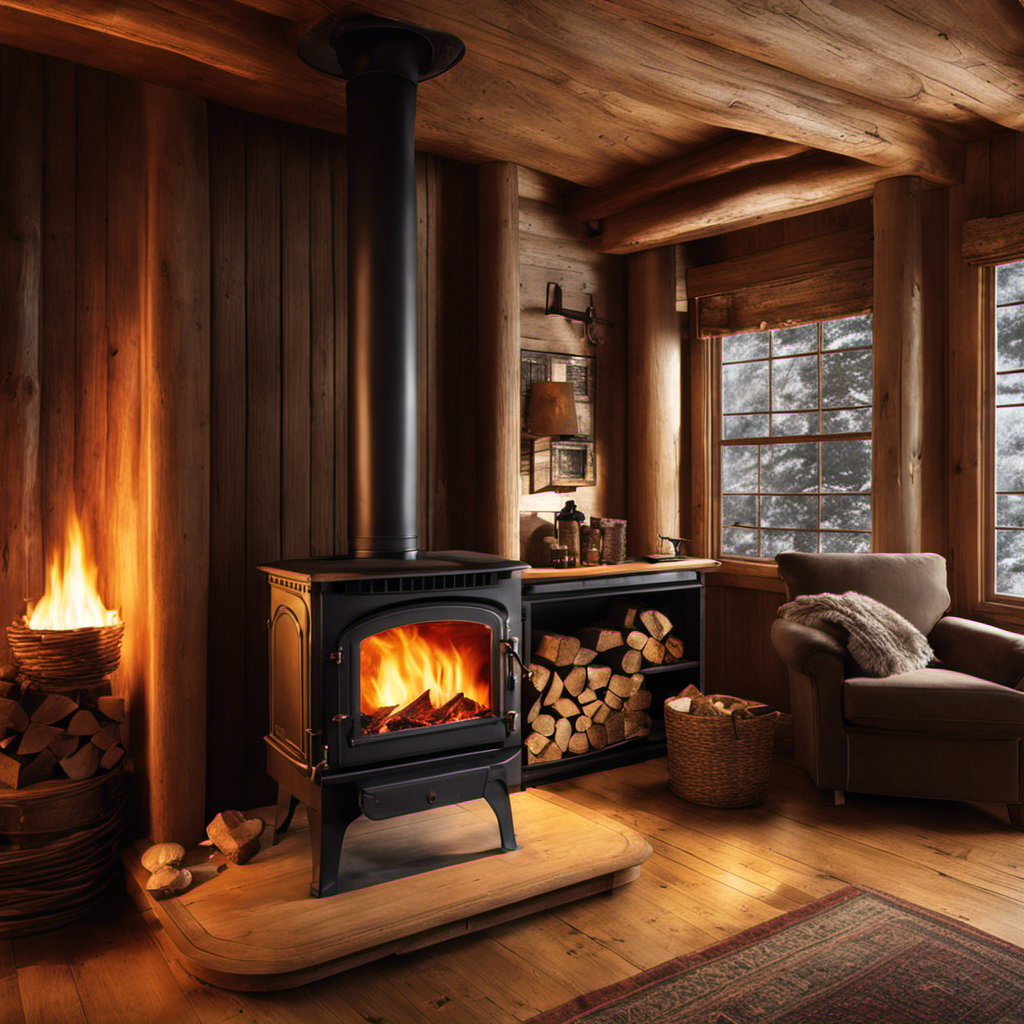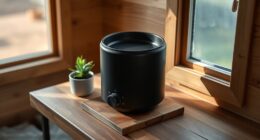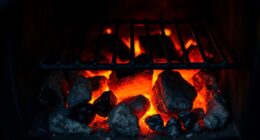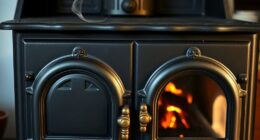Starting and keeping a fire in a federal airtight wood stove can be daunting at first, but with the proper knowledge and techniques, it is actually quite manageable.
In this article, I’ll guide you through the steps to successfully light and maintain a fire in your wood stove.
From understanding the basics to controlling the heat output, I’ll provide you with tips and tricks for safe and efficient fire control.
Let’s dive in and master the art of wood stove fires!
Key Takeaways
- Federal airtight wood stoves efficiently burn wood for warmth and cost savings.
- Properly prepare wood and firebox for a successful fire.
- Lighting a fire in a wood stove requires arranging kindling in a teepee shape and gradually adding larger wood pieces.
- Controlling and maintaining the heat output of a wood stove involves adjusting air intake and damper controls.
Understanding the Basics of a Federal Airtight Wood Stove
I really need to grasp the basics of how to operate a federal airtight wood stove.
Federal airtight wood stove designs are specifically built to efficiently burn wood, providing both warmth and cost savings. One of the key benefits of using a federal airtight wood stove is its ability to retain heat for a longer period of time. This means that you can enjoy a steady and consistent heat output throughout the day.
Another advantage is that these stoves have airtight seals which prevent smoke and gases from escaping into your home, reducing the risk of indoor air pollution.
Understanding the basics of operating a federal airtight wood stove is crucial for a successful fire.
Preparing Your Wood and Firebox for a Successful Fire
To ensure a successful fire, it’s important to properly prepare the wood and firebox in your federal airtight wood stove. One key aspect of preparation is wood seasoning. Seasoned wood, which has been dried for at least six months, burns more efficiently and produces less smoke. It’s essential to choose the right kind of wood for your stove, such as hardwoods like oak or maple, as they burn longer and provide more heat. Additionally, selecting the right kindling is crucial to get the fire started. Dry twigs, newspaper, or commercially available fire starters are great options. Here is a table summarizing the key points for preparing your wood and firebox:
| Preparation Step | Tips and Guidelines |
|---|---|
| Wood Seasoning | – Season wood for at least six months for optimal burning. |
| Kindling Selection | – Choose dry twigs, newspaper, or fire starters to ignite the fire. |
Step-by-Step Guide to Lighting a Fire in Your Wood Stove
Using dry kindling and seasoned wood, I carefully ignite a fire in my wood stove, following each step of the step-by-step guide.
Lighting a fire in a wood stove requires proper technique to ensure a successful and efficient burn. First, it’s important to gather the necessary materials, including newspaper, small twigs, and larger pieces of wood.
Next, arrange the kindling in a teepee shape, leaving enough space for air to circulate. Light the newspaper beneath the kindling, using long matches or a lighter. As the fire starts to catch, gradually add larger pieces of wood, ensuring they’re properly placed for optimal airflow.
Troubleshooting common fire starting issues such as a smoky fire or difficulty in igniting can be resolved by checking for proper draft, using dry materials, and adjusting the damper accordingly.
Controlling and Maintaining the Heat Output of Your Wood Stove
Maintaining a consistent heat output in my wood stove requires regular adjustments to the damper and fuel consumption. To achieve this, there are a few key factors to consider:
Ventilation: Properly adjusting the air intake and damper controls is crucial for controlling the heat output. Opening the damper allows for more oxygen flow, increasing the intensity of the fire, while closing it reduces air flow, lowering the heat output.
Fuel Consumption: The type and amount of fuel used directly affects the heat output. Choosing the right size and quality of firewood, along with proper stacking techniques, ensures a steady and efficient burn.
By mastering the art of adjusting ventilation and fuel consumption, one can maintain a consistent temperature in their wood stove.
Now, let’s explore some tips and tricks for safe and efficient fire control in a federal airtight wood stove.
Tips and Tricks for Safe and Efficient Fire Control in a Federal Airtight Wood Stove
After years of experience, I’ve discovered that adjusting the damper and monitoring the wood fuel supply are the keys to safe and efficient fire control in my federal airtight wood stove.
Fire safety should always be a top priority when using a wood stove, and proper ventilation plays a crucial role in achieving this. The damper controls the amount of air flowing into the stove, which affects the combustion process. By adjusting the damper, you can regulate the fire’s intensity and maintain a steady temperature.
It’s important to ensure that the wood fuel supply is properly managed to avoid overloading the stove and causing a potential fire hazard. Regularly check the wood supply and add logs as needed to maintain a consistent and controlled burn.
Remember to always follow the manufacturer’s guidelines for your specific wood stove model and consult a professional if you have any concerns about fire safety or ventilation.
Frequently Asked Questions
How Often Should I Clean My Federal Airtight Wood Stove?
I clean my federal airtight wood stove regularly to ensure proper maintenance. Regular inspections are important to keep it functioning safely and efficiently. It’s crucial to know how to properly maintain a federal airtight wood stove.
What Type of Wood Is Best to Use in a Federal Airtight Wood Stove?
Well, when it comes to starting and controlling a fire in a Federal Airtight Wood Stove, the type of wood you use is key. The best firewood would be dry hardwoods like oak or maple. And don’t forget proper firewood storage!
Can I Use Newspaper as Kindling in My Wood Stove?
Yes, you can use newspaper as kindling in a wood stove, but there are also other alternatives such as fire starters. It’s important to ensure proper airflow and control the fire for optimal performance.
How Can I Prevent Creosote Buildup in My Wood Stove Chimney?
To prevent creosote buildup in a wood stove chimney, it’s crucial to take safety precautions. Regularly clean the chimney and use properly seasoned wood. This ensures efficient burning and reduces the risk of chimney fires.
Is It Safe to Leave a Fire Unattended in a Federal Airtight Wood Stove?
Leaving a fire unattended in a federal airtight wood stove is not recommended due to the potential risks. It’s essential to prioritize safety and avoid any common mistakes when starting and controlling a fire in this type of stove.
Conclusion
Congratulations! You’re now equipped with the knowledge and expertise to start and control a fire in your federal airtight wood stove like a seasoned pro.
With our step-by-step guide and helpful tips, you’ll be able to enjoy safe and efficient fires that keep you warm and cozy.
So go ahead, ignite that fire and bask in the warmth of your newfound fire mastery.
Stay toasty, my friends!
Growing up surrounded by the vast beauty of nature, Sierra was always drawn to the call of the wild. While others sought the comfort of the familiar, she ventured out, embracing the unpredictable and finding stories in the heartbeat of nature.
At the epicenter of every remarkable venture lies a dynamic team—a fusion of diverse talents, visions, and passions. The essence of Best Small Wood Stoves is crafted and refined by such a trio: Sierra, Logan, and Terra. Their collective expertise has transformed the platform into a leading authority on small wood stoves, radiating warmth and knowledge in equal measure.

